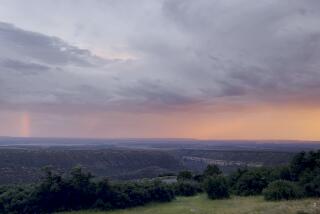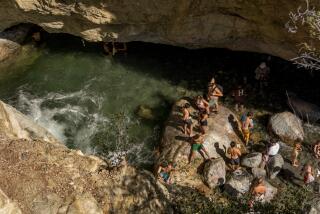It’s a jungle all right in Guyana
Reporting from Kaieteur National Park, Guyana — Wary of jaguars, Wally Prince creeps around a cave formed by overhanging boulders. A few small bats drop from the rocks, flutter about and find new resting places. Our guide, a native of Guyana, is a man on a mission.
“Watch out for pit vipers,” he says, sneaking around a tree. “Those are mean guys. Imagine a rattlesnake 8 feet long. With no rattle.”
There are many things to be wary of in the rain forest: jaguars, anacondas, tarantulas, fierce bullet ants whose sting feels like a gunshot wound. I would very much like to see a jaguar — or even a colorful frog. But our goal on this hike is the elusive cock-of-the-rock, one of Guyana’s most colorful birds. Prince is taking us to one of their leks, where the males engage in display behavior.
FOR THE RECORD:
Guyana travel: In the May 29 Travel section, an information box accompanying an article on Guyana said Virgin America flies to Georgetown, Guyana. It does not; the correct airline is Virgin Atlantic. —
We climb a bit, tiptoeing around the cave. Prince’s eyes light up as he puts his finger to his lips. There, suspended among the trees like a persimmon, is a brilliant cock-of-the-rock. We train our binoculars on this odd-looking bird, whose head resembles the feathered crown of a Hawaiian king. The bird casts us a sidelong glance; we are not the admirers he’s been waiting for.
Tourists sought
Looking for obscure creatures in an obscure country sums up the Guyana experience. Though the place is an environmental Eden, it is known to few people — who, when they think of Guyana, think of one thing only.
Jonestown is the elephant in the room. When a dramatic event puts a tiny place on the map, the two become almost inseparable. In Guyana’s case, people know little else about the country. They don’t know that it’s a little bigger than Washington state — with about 15% of the population. That it’s the only English-speaking country in South America, with the largest percentage (80%) still covered by virgin rain forest. Or that within those pristine forests dwell about 8,000 species of plants, many of which live nowhere else on Earth.
Viewed from the air, Guyana’s vast rain forest looks like a tightly woven carpet. I feel uneasy: If our plane runs into trouble, there’s virtually no place to land.
Guyana is also in a precarious position. Because it has decided to conserve the forests — and forsake big industry — it’s trying to raise its profile in the travel and birding worlds.
A few well-appointed lodges, such as Surama, already cater to international visitors. New ones are springing up or being improved. In 2005, Canada’s international development agency funded a harrowing canopy walkway, 90 feet high in the trees, near the fledgling Atta Rainforest Lodge. And just before Christmas, the Iwokrama Research Centre & Lodge optimistically ordered four cases of crystal wine glasses.
A harsh forest
My visit is hosted by the United States Agency for International Development, or USAID, an American group supporting Guyana’s attempts at community-based tourism. Our small group of journalists and tour operators has nine days to sample the country’s attractions.
On our third afternoon we arrive at Maípaíma Eco-Lodge, a rough drive from the southwest border town of Lethem. Our rooms are rustic, but the food is delicious: fried rice, stewed vegetables and baked chicken, with fried plantains in cream for desert. When I compliment our host Guy Fredericks (a member of the Macushi, one of Guyana’s nine Amerindian tribes), he invites me into the kitchen “to meet the head cook.” As I duck in, he points upward toward a huge tarantula nesting in the grass ceiling. “That’s Shirley,” Fredericks says. “We take our advice from her.”
The next day we rise early for a grueling, 10-mile hike to Jordan Falls, a local landmark. Contrary to shampoo commercials, there is nothing gentle about the rain forest. We slog through creeks and over slippery rocks, dripping with sweat, up and down along steep trails. Fredericks stops every 20 paces to listen for the call of a bell bird, look for toucans or examine a medicinal plant.
The rain forest is not for everyone. Its closeness can induce claustrophobia, and it’s sweltering. Fredericks admits it’s not second nature. “Every time I do this, it challenges me to my limit,” he says, panting. After working six years in Brazil, Fredericks returned home, gambling that that area’s attractions could be turned into an income stream.
When we arrive at Jordan Falls, that pipe dream seems possible. Wild waters cascade from high in the rain forest, fanning out over a broad stone cliff. There’s a fantastic panorama across the jungle and distant hills. We swim in Jacuzzi-like pools, enjoy a fresh-cooked dinner and sprawl on the warm rocks, staring at the infinite stars. It’s a gem of a place — and, in a country that gets fewer than 2,000 tourists a year, we’re among the first 100 foreigners to visit.
Word spreads
Our hosts work us hard. Though Guyana is small, navigating the rain forest and savannah is slow. A typical day might see us wake at 5:30 a.m., board an open motorboat for a two-hour ride for breakfast at a river otter rescue project, follow the river for three more hours to an eco-lodge for a locally farmed lunch, sing “Old MacDonald” at a primary school in a nearby Amerindian village, spend the afternoon staggering up a mountain to a viewpoint, and descend to a caiman-infested lake in time to watch Victoria amazonica — the world’s largest water lily — open at sunset, its gorgeous white petals unfolding in the dusk. Dinner and debriefing follow.
If the pace is rough for us, the evolution of eco-tourism in this South American backwater is equally challenging for Amerindians. Sitting on the bank of the dark Rupununi River, a few yards from the pastoral Rewa Eco-Lodge, I’m joined by local manager Dicky Alvin.
Taking an agricultural hamlet in the Amazon and shaping it into a destination attractive to world travelers is not, he informs me, an easy task. “It doesn’t happen overnight,” Alvin says. Where will the visitors stay? Who will prepare their food? What about plumbing, lighting, refrigeration? What does the area have to offer?”
The word “tourism,” Alvin says, was alien to his village and had to be explained — along with “eco-lodge” and “en suite bathroom.” And Rewa’s construction — which took four months and considerable resources — was a leap of faith. Then the locals opened the doors, stepped back and waited for the crowds. The first year, a single visitor came. The second year, there were two.
Business is picking up. There were 80 visitors in 2009 and 140 in 2010. As occupancy grows, the Amerindians are warming to the relationship. “Before, tourists were scary,” Alvin recalls. “Almost like wildlife. Now we have learned not to fear them and that they can be very friendly.”
A long way down
Most of the lodges scattered through Guyana’s rain forest and savannah offer similar attractions: lush foliage, exotic birds and the chance to spot jaguars, monkeys or threatening reptiles. But the country’s signature attraction is breathtaking Kaieteur Falls, plunging into the Potaro River with a drop five times the height of Niagara.
After landing at the small airstrip near Kaieteur National Park, we begin our short hike to the headwaters. There are cocks-of-the-rock here, to the delight of the birders. I tell Prince my obsession: to see Guyana’s famous golden frog. I like frogs. In early 2010, after seeing Disney’s “The Princess and the Frog,” I tried to snag “frogprince2010” on gmail, to no avail.
The golden frog is a poison dart frog, endemic to this part of the Amazon. It is found only in bromeliads, perched near pools of water that collect between the tropical plant’s broad green leaves.
Golden frogs are skittish and will vanish into their private pools if disturbed. With the mighty waterfall roaring in the background, Prince moves slowly from plant to plant, parting the leaves to peer inside. Finally, with a wide-eyed grin, he waves me over. I peer inside. The tiny amphibian seems lost in thought, serene in his (or her) chlorophyll cave. I set my camera to macro and snap several pictures.
“Can you send me one of those?” Prince asks.
“Of course. What’s your email address?”
“It’s frogprince2010,” he says. “
I didn’t believe it, either. But so it is.
We continue to the edge of the river canyon and watch Kaieteur’s waters sluice into the foam below. It’s a mesmerizing sight, but not the best metaphor for Guyana’s emergence as a destination of choice. For that, I’d have to choose the Victoria amazonica water lily. Guyana’s bud is just opening — but when it blooms, the flower will be quite a prize.
More to Read
Sign up for The Wild
We’ll help you find the best places to hike, bike and run, as well as the perfect silent spots for meditation and yoga.
You may occasionally receive promotional content from the Los Angeles Times.






